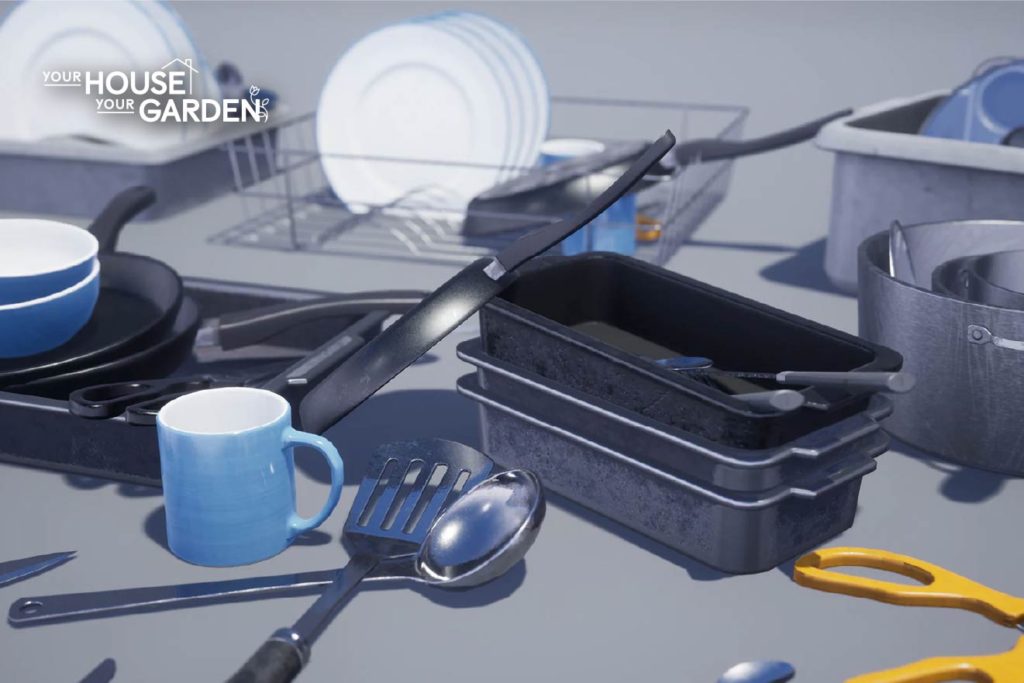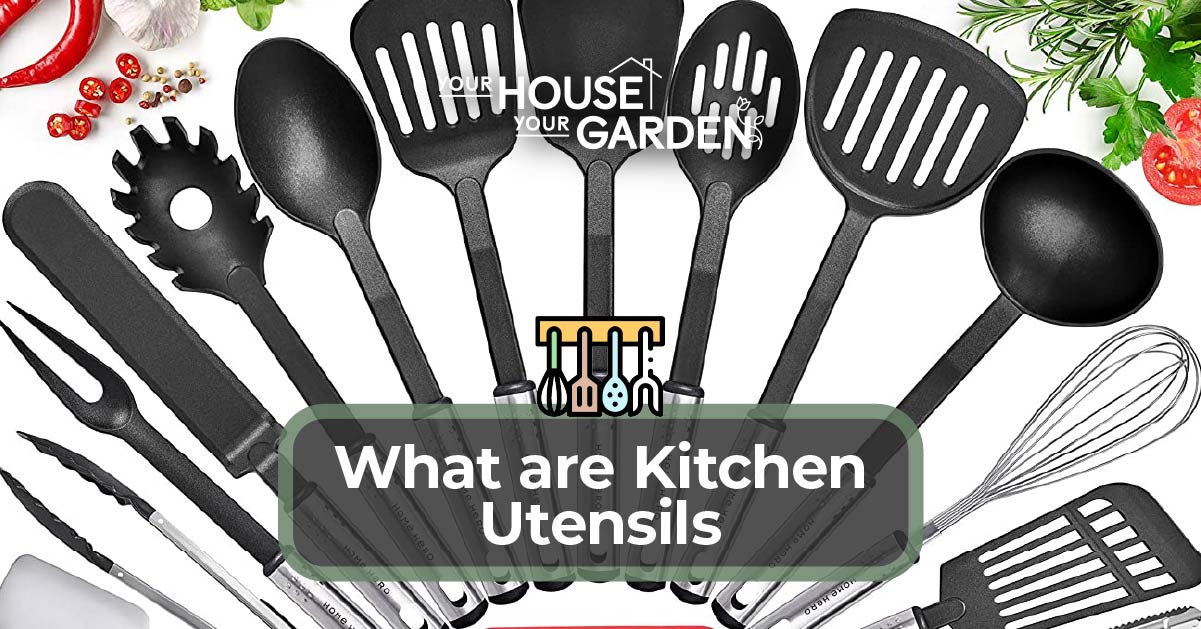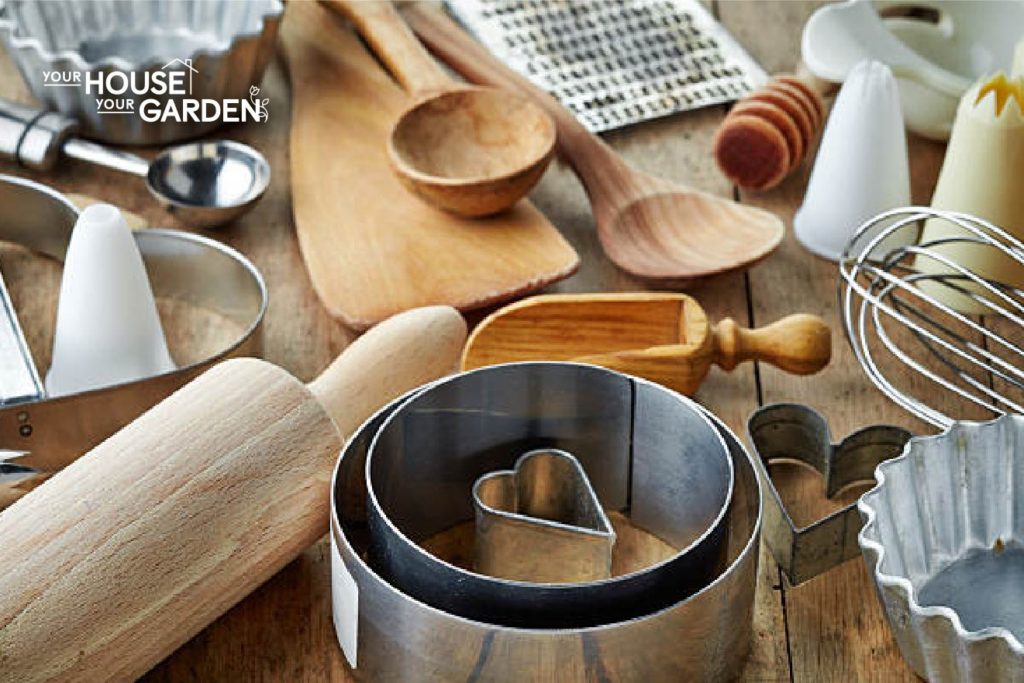A utensil is a handheld device used to prepare or consume foods. The main purpose of kitchen utensils is to assist with kitchen tasks, like serving, cutting, chopping, or mixing. Some kitchen utensils are also eating utensils, like forks, spoons, and knives, and are used as a tool to transport food from a plate or bowl to the mouth.
A kitchen utensil may also be referred to as a culinary utensil if it’s used to prepare ingredients or meals. Boiling utensils are devices that are heat-resistant and used to cook foods in a pot.
The main types of utensils include bakeware, cookware, and ovenware. These subcategories of utensils refer to the specific cooking tasks that each one is used for.
The history of cooking utensils dates back to the Stone Age. During this time, people used mortar and pestle to prepare and make foods. While the kitchen utensil went through many changes over the years since the Stone Age, today’s kitchen utensils are primarily made with stainless steel materials.
What is the definition of a kitchen utensil?
A kitchen utensil is a small device used to assist with food preparation tasks. Kitchen utensils cover all small tools used in the kitchen. The definition of a kitchen utensil may be further defined by its purpose, including cookware, bakeware, or ovenware. Eating utensils are also a type of kitchen utensil.
What are the types of kitchen utensils?
Kitchen utensils include bakeware, cookware, and ovenware. All kitchen utensils are a type of kitchenware, meaning they’re used in the kitchen to assist with kitchen tasks. These are the types of kitchen utensils:
Bakeware
Bakeware is a kitchen utensil used to assist with baking tasks. Bakeware includes devices that hold ingredients during baking like casserole dishes or baking sheets. The primary function of bakeware is to hold ingredients while baking. A few common types of bakeware include:
- Baking pan: A baking pan is a type of bakeware that stores liquid batter while it thickens during baking in the oven. Baking pans are commonly made from stainless steel like other kitchen utensils including pots and pans because it’s non-stick and durable.
- Bundt pan: A bundt pan is a type of bakeware that forms liquid batter into a round shape with a hollow center. Bundt pans are most commonly made with stainless steel materials unlike some other bakeware utensils like casserole dishes or mixing bowls.
- Loaf pan: A loaf pan is a type of deep dish bakeware that bakes liquids into the shape of a loaf. Stainless steel loaf pans are durable and prevent burning, unlike glass casserole dishes or loaf pans.
- Springform pan: A springform pan is a type of bakeware that shapes ingredients into a round cake form and comes with a removable bottom. Springform pans are commonly made with stainless steel materials because this prevents them from burning, unlike glass pans.
Cookware
Cookware is a type of kitchen utensil used to assist with cooking tasks, like grilling or frying ingredients. The primary function of cookware is to hold ingredients during the preparation of cooking. A few of the most common cookware include:
- Frying pan: A frying pan is a type of cookware that transports heat from a cooktop to ingredients on the pan. Frying pans are made with aluminum or stainless steel, with stainless steel being the preferred material for durability and to prevent burning or scratching.
- Stockpot: A stockpot is a large, round pot with a flat bottom that boils stock or broth ingredients. Stockpots most commonly come in carbon steel materials coated with a non-stick enamel that prevents ingredients from burning.
- Wok: A wok is a circular-shaped frying pan. Woks commonly come in carbon steel materials because it’s non-stick and durable, unlike metal frying pans.
- Saute pan: A saute pan is a frying pan with straight sides. A saute pan is commonly made with stainless steel materials that prevent burning and liquids from escaping.
Ovenware
Ovenware is a type of kitchen utensil used to assist with oven tasks, like baking or cooking casserole dishes. The primary function of ovenware is to transport and cook foods in the oven. A few types of ovenware include:
- Dutch oven: A Dutch oven is a heavy-duty cooking pot with a lid. Dutch ovens are made with seasoned cast iron materials, which are heavier than other cookware or ovenware.
- Baking dish: A baking dish is a rectangular-shaped dish used in the oven. Baking dishes are usually made of glass materials that take a while to heat but don’t burn ingredients.
- Pizza stone: A pizza stone is a flat utensil that goes directly on the oven rack. Pizza stones are made with ceramic or stone to transfer heat to the pizza.
- Roasting pan: A roasting pan is a large, oven-safe pan used for roasting. Roasting pans are usually made with thick stainless steel or glass to hold the heavier weight.
What is the purpose of kitchen utensils?
The primary purpose of kitchen utensils is to assist with kitchen tasks. Here are a few common uses of kitchen utensils:
- Stir ingredients using cookware when cooking, like soups or sauces.
- Fry ingredients using cookware like with a frying pan.
- Heat and cook casseroles in the oven using ovenware.
- Prepare ingredients, including cutting or chopping.
- Boil liquids with boiling utensils, like soup or pasta sauces.
- Scoop ingredients to serve.
- Roast meats with cooking utensils, like chicken or beef.
- Bake desserts using bakeware, like cakes or pies.
The material of each kitchen appliance affects its uses. Cookware is commonly made with stainless steel materials, making it useful for all types of cooking tasks. Bakeware is commonly made with aluminum materials that are placed inside the oven. Ovenware is also made with aluminum materials and placed in the oven but is used to bake ingredients rather than cook.
Learning how to use kitchen utensils can help you speed up the total time it takes to make meals.
What are the kitchen utensil materials?
Kitchen utensils come in a variety of different materials, which affects their use case and durability. Cookware is commonly made with stainless steel materials because they’re durable and long-lasting. Ovenware may be made with stainless steel or glass materials because they’re both heat-resistant and safe for use in the oven. Glass is usually not intended for other cooking tasks, like frying or boiling. Bakeware is commonly made with stainless steel materials because they are non-reactive, making them safe for use with liquids and acidic foods.
What are the bakeware materials?
There are two types of materials for bakeware, depending on their purpose. Pans including baking, bundt, loaf, and springform come in aluminum or stainless steel materials. Pans as bakeware are made with heat-resistant materials because they have to sustain high temperatures in the oven.
Unlike pans, bakeware can be made from glass because it’s made with materials that are oven and heat-resistant.
What are the cookware materials?
There are four primary cookware materials, including stainless steel, aluminum, copper, and carbon steel. Cookware including frying pans and pots is usually made with stainless steel materials because they’re burn-resistant. Unlike bakeware, cookware often includes a rubber or plastic handle because it’s not used in the oven.
What are the ovenware materials?
There are two primary types of materials for ovenware, including stainless steel and glass. A pan as ovenware can be made with glass materials. Glass is safe in the oven, unlike a pan as cookware that goes on the cooktop. A pot as ovenware won’t include silicone handles because they’re not oven friendly. Ovenware utensils are made with oven-safe materials since they are used in the oven to heat ingredients.
What are the different kitchen utensil sets?
A kitchen utensil set is a combination of kitchen tools with a similar purpose. Kitchen utensil sets for eating may include forks, spoons, and knives. Kitchen utensil sets may also be available in subcategories, including ovenware, cookware, and bakeware.
An ovenware kitchen utensil set may include baking pans, baking sheets, cake pans, and muffin tins. A cookware kitchen utensil set includes pots, pans, skillets, and saute pans. A bakeware kitchen utensil set may include baking tins, cookie sheets, loaf pans, and measuring cups in different sizes.
What is the diversity and utility of kitchen utensils?
The diversity of kitchen utensils refers to the way in which a culture or location uses different kitchen utensils. The utility of kitchen utensils refers to the method in which someone, or a population of people, uses a utensil. Diversity and utility continue to change over time as the available utensils and cooking trends also change.
For example, copper utensils were popular in earlier times. As people found materials like stainless steel to be better suited for daily use, copper utensils weren’t used as frequently,
Culinary utensils may also look different, depending on where you’re at in the world.
In Asian countries, kitchen utensils like chopsticks are more common than forks and spoons. In Indian countries, it’s more acceptable to eat foods with hands rather than using utensils.
Why is the 19th Century important to the history of kitchen utensils?
The 19th Century is important to the history of kitchen utensils for many reasons. Previously, kitchen utensils were primarily made out of easy-to-source materials like stone or wood.
During the 19th-century, a middle-class to affluent subset population emerged, who made meals about more than dining. Cooking became a way to host parties and spend time with others. A lot of households hired kitchen staff to maintain the kitchen because preparation and cooking took sufficient time. This led to the invention of the kitchen utensil because it shortened the time it took to complete kitchen tasks.
Even households that didn’t have access to kitchen staff wanted access to faster, more convenient methods of cooking during the 19th-century, which led to the invention of kitchen utensils like toasters, potato mashers, food choppers, and sausage stuffers.
What material was popular for utensils before the 19th century?
Before the 19th-century, utensils were commonly made from slate. Slate and ivory were easy to find and source, making them a popular material for kitchen utensils. Many of the first kitchen utensils were used for cooking, rather than eating. They were used to help people cook items over a hot fire without the risk of burning themselves.
Over time, materials like terracotta became more common in kitchen utensils. Copper was also used in some wealthier parts of Europe, like Tudor England. It wasn’t until the early-20th century that stainless steel became the norm for kitchen utensils. Today’s utensils can also be found in aluminum or metal.

How has the production of kitchen utensils increased since the 19th century?
The production and use of kitchen utensils have continued to increase since the 19th century. In the early-19th century, forks became commonplace in the United States, leading to increased demand. The conclusion of the industrial revolution increased the number of households who wanted to improve cooking time using culinary utensils.
The demand for specific utensil items has also changed. During the early-19th century, cooking utensils like stewpots, beanpots, sardine forks, and jelly knives were common. Today, in countries like the United States, Canada, and European countries, necessary utensils include spoons, bowls, baking pans, and cooking pots.
In addition to the higher demand for kitchen utensils, the materials most in demand have also changed since the 19th century. Plastic utensils became popular at the beginning of the 20th-century. Today, plastic utensils are considered to be bad for the environment and many cities are banning them.
From 2010-to 2018, the retail sales of kitchen utensils and appliances have increased from $1.03 U.S. billion to $1.2 U.S. billion. Utensil brands also changed throughout the 20th-century. Some brands that were common in the 19th-century are still around today, like GE and Kenmore. Other brands are no longer available or have been absorbed by other brands, including JeanVintage or Maytag.
How have cookbooks changed the use of essential kitchen utensils?
Cookbooks became popular in the late 20th-century. This led to TV shows and internet programs focusing on cooking specific dishes using certain kitchen utensils.
As new foods or diets are introduced in cookbooks, the demand for specific kitchen utensils used in them also increases. Many of the original recipes in cookbooks are made from scratch, leading to people buying kitchen utensils they didn’t already own.
The first cookbook in history is Culinary Matters, written by Apicius, a Roman merchant, and epicure. This book focused on cookery and dining in imperial Rome times. In more modern times, Eliza Acton, an English food writer, released a time-saving cookbook called Modern Cookery for Private Families. Acton was the first to list all recipe ingredients. Recipes used common kitchen appliances of the Victorian times, like electric ovens and firewood. Isabella Beeton, an English journalist, followed almost 15 years later with her book that included fast recipes and child-rearing tips. The book was called Mrs. Beeton’s Book of Household Management and it offers cooking and housekeeping tips for Victorian households.
By the 19th-century, most recipes in cookbooks required the use of stoves, leading to an increased demand for them. Most of today’s cookbooks are digital and written by famous chefs or culinary experts.
These cookbooks often use common utensils that are already found in the U.S. or European countries, like pots, pans, cookie sheets, or mixing bowls. Some recipes in cookbooks may include preparation utensils like vegetable peelers, wooden spoons, slotted spoons, and serving tongs. They may also include specific bakeware items, like bundt pans or cake pans.
How do kitchen utensils save time?
Kitchen utensils save time when completing tasks like cooking, prepping, boiling, and baking. A kitchen utensil saves time for the cook by shortening the time it takes to prepare or cook different ingredients.
For example, as cookware, a pan can fry an egg faster than bakeware. Frying an egg with bakeware takes between 5-6 minutes at 425 degrees, whereas it takes only 2-3 minutes with a pan on medium heat.
As ovenware, a casserole dish can speed up the time it takes to bake pasta dishes. It’s possible to use a saucepan to cook pasta, but this takes an average of 30 minutes and is likely to burn ingredients, whereas a casserole dish can cook ingredients in an average of 20 minutes with consistent heating.
As bakeware, cooking muffins in the oven with a baking sheet can take 30-40 minutes, whereas using a muffin pan can take 15-20 minutes and better form the shape of a muffin.
What is the etymology of the utensil?
Utensil comes from the Latin meaning, “things for use”. The word kitchen comes from the Latin noun coquina, which means kitchen. The words kitchen and utensil used together describe things for use in the kitchen. The history of the etymology of the utensil has adapted over time to describe specifically utensils used when completing kitchen tasks.
Kitchen utensils may be referred to as their specific purpose, rather than as the general kitchen utensil definition. For example, a cleaning utensil may include a vacuum cleaner or broom and may be used anywhere in the house. Kitchen utensils can also be categorized by their purpose with cooking utensils used to assist with cooking tasks. Baking utensils are things for use to speed up the baking time. Kitchen utensils may also include items like graters or colanders.
What are a few synonyms of kitchen utensils?
Kitchen utensils are sometimes referred to by other names. Kitchen utensils may also be referred to as:
- Housewares: Housewares refers to any household items, including tableware or kitchen utensils. Housewares are a larger group of items used in the household.
- Cookware: Cookware refers to a sub-set of kitchen utensils used specifically when cooking. Cookware is a type of kitchen utensil.
- Bakeware: Bakeware refers to a sub-set of kitchen items used to assist with baking tasks. Bakeware is a type of kitchen utensil.
- Ovenware: Ovenware is a sub-set of kitchen items used to assist with cooking tasks in the oven. Ovenware is a type of kitchen utensil.
While these words describe a sub-category of kitchen utensils, they are often used
synonymously to describe a tool used in the kitchen. A kitchen utensil can also be referred to as a kitchen tool. A kitchen tool can also refer to tools, like screwdrivers or hammers, used specifically in the kitchen.
What is the first known use of utensils in literature?
The first known use of utensils in literature dates back many years to Neolithic times (5000 – 2000 BC), which discussed the use of primitive blades as knives. Spoons were made during this time from shells or horns. The first fork in literature was the pitchfork during Egyptian ceremonial events. The Roman Empire brought even more kitchen utensils that assisted with cooking, like meat hooks and spatulas.
People in many cultures began to make improvements to utensils. By the 19th century, the United States popularized many kitchen utensils.
What is the difference between a kitchen utensil and a kitchen appliance?
The primary difference between a kitchen utensil vs. a kitchen appliance is the intended purpose of each. A kitchen utensil is used to assist with kitchen tasks, whereas a kitchen appliance is an electric-powered device used to cook or bake items. Kitchen utensils are most commonly used in the preparation of cooking tasks and a kitchen appliance is used to cook items.
Kitchen utensils and kitchen appliances both serve a primary function in the kitchen, but storage capabilities can also differ. Whereas kitchen utensils can easily be cleaned and stored away in a cupboard or drawer, kitchen appliances are much larger and heavier devices that stay in one place in the kitchen. A kitchen appliance is also often made with stainless steel materials, whereas kitchen utensils can come in a variety of materials including aluminum, copper, metal, or plastic.


